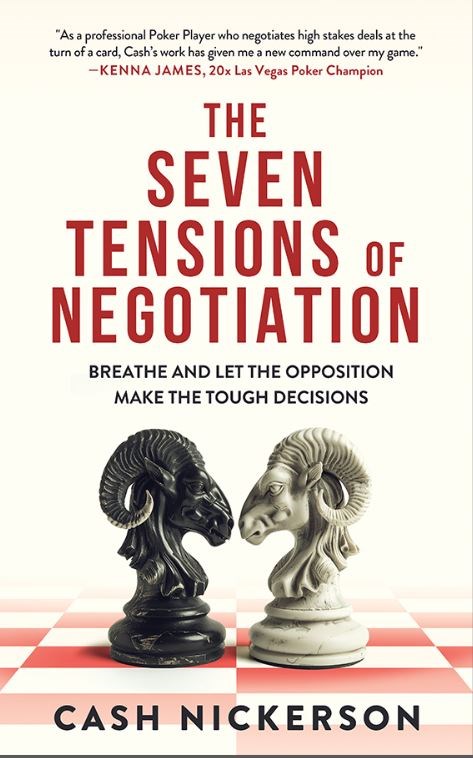An Excerpt from The Seven Tensions of Negotiation
Negotiation is a fundamental aspect of human interaction that plays a crucial role in various aspects of life, including personal relationships, business dealings, and conflict resolution. It is often presented as a direct, one-on-one exchange where two parties come together to find a mutually beneficial solution.
In his new book, The Seven Tensions of Negotiation, Cash Nickerson presents a fresh perspective: what if, instead of simply saying yes or no, we consider adding “maybe not” to our negotiation strategies?
In this excerpt, Nickerson highlights the common tensions that often emerge during negotiations and explains how these tensions can be used to achieve more effective results. By recognizing and understanding these tensions, Nickerson suggests that anyone can manage stress more effectively and improve their negotiation outcomes, especially when the stakes are high.
◊◊◊◊◊
We join in interpersonal unions and relationships based on how well we negotiate with each other. As organized collections of people, we negotiate terms of exchange, terms of labor, and conditions of interaction. We do this commercially through companies and collectively as nations. When we can’t sort matters commercially, we litigate. When nations can’t resolve differences through negotiation, wars erupt. In the US alone, large companies in 2021 spent $23.71 billion on litigation. How do we measure the human cost of war? In the one hundred years of the 20th century, 231 million people died as a result of wars. What are we doing to reduce the corporate waste from litigation expenses and the loss of life from conflicts?
If we can improve how well we negotiate, we can change the world.
Imagine the most basic of negotiations, with just you and one other person. Imagine you walk through a door into a conference room with a conference table and two chairs on either end. In the room, there is another person, whom you may or may not know. They are seated at the far end of the table. In the middle of the table is a Snickers bar. Next to the Snickers bar, there is a shiny table knife on a plate. There is a note on the table in front of what is presumably your chair. You sit down in the chair and read the note. The note says, “The Snickers bar in the middle of the table is for you and the person seated across from you.”
After you read the note, you look up at the person across from you. What do you do? How do you feel? Teasing out your likely feelings, concerns, and anxieties, you likely have the following tensions:
- Who is the person at the other end of the table? With whom am I negotiating? Do I know them? You will have tension about the person, and we call this Relationship Tension.
- What do I want? What will I get? How much of the Snickers bar should be mine? What do I deserve? What makes me entitled to it? What is my claim? You will have tension about your rights and obligations regarding who should get what, and we call this Outcome Tension.
- How are we going to decide who gets what part of the candy bar? What are the rules of engagement? Will we talk with each other? Will we take turns arguing who should get what? What if we can’t decide right away? Should we schedule a follow up call or meeting? What should we do with the candy bar in the meantime? You will have tension about how to decide who gets what, and we call this Process Tension.
- How long do we have to perform this sharing exercise? What other time commitments do I have? How about the timing of the person across the table? How long does the candy bar last? You will wonder how time is a factor, and we call this Timing Tension.
- Is the person at the other side of the table stronger, smarter, or more powerful than me? What does she or he know that I don’t? What if they just take it? Does either party have the ability to influence or control the other? You will worry and have tension about your relative strengths as you sit there. We call this uncertainty Leverage Tension.
- Is there someone who can advise me or work on my behalf? Do I need an intermediary to help me? As I sit and ponder my situation and all the other tensions, I have to wonder whether I am in over my head. Can I handle this or do I need some help? Or am I in the room on behalf of someone else. Whether you need help or are helping someone else, you are facing what we call Agent Tension.
- Who else would benefit from my candy bar sharing? Is there a family or team involved? Is it my decision to make, or do I have to get permission, approval, or consensus from others? Is there a company policy on how I should approach the negotiation? Who else am I supposed to consult? As you think thoughts like this, you are experiencing Team Tension.
What is the very next thing you do? Should you speak first? Should you just split the candy bar in half? Should you engage in chit chat before talking about the candy bar in the middle of the table? Should you brainstorm all the reasons you should get more than half of the candy bar? Maybe you didn’t have breakfast. Maybe you can convince the other person that the candy bar is unhealthy, and you are doing them a favor by eating it all yourself.
Your mind will race to think of the possibilities, probably before you have even asked yourself whether you like Snickers bars.
Suppose, instead of wading through the swirling tensions, you could master them. Suppose by sorting the tensions and learning how to master them, you could quickly and efficiently resolve the candy bar problem. Suppose while the person on the other end of the table was feeling everything described above—with their palms sweating, heart beating quicker, brain under stress—you calmly analyzed and applied techniques to resolve the tensions fearlessly and without regret.
The thesis of my book is that all negotiations involve tension, specifically, the seven tensions I described at the beginning of this chapter. Learning to segment, understand, and manage tensions rather than avoid them is critical to our ability to negotiate successfully with each other. I believe that even when we teach negotiation, we too often teach tension avoidance techniques to gain a “win-win” scenario rather than teach how to manage tensions in a head on and transparent way. With the ability to identify and segment the seven tensions and an understanding of the tools to ease those tensions, you will master every negotiation you encounter.




